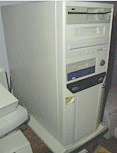 |
Hardware Specifications Case (Incl Power Supply) |
 |
Hardware Specifications Case (Incl Power Supply) |
|
You wouldn't think that the decision on
purchasing a case would be that important, but it's
probably the one thing where there is the biggest chance
of incompatibility with the motherboard. The problem is
the wires that connect the functions on the case to the
motherboard. Most cases have an on/off switch, a reset
button, a turbo button, a digital speed readout and a
speaker. Each one of these has a wire that connects it to
the motherboard, but the connectors are not standard. If
you don't care if all the buttons work, then you don't
have a major problem. Who uses the turbo button? Most
people don't use the reset button either, but it would be
nice if it worked. The speaker connection is probably the
one that seems to have the most incompatibility with
connectors. The key is to check the motherboard you plan
to buy and write down the way the pins are set up for the
connection of these wires, then make sure that the wires
on the case match this configuration. Sometimes the best
choice is to buy the case the same place you buy the
motherboard to make sure they're compatible. The digital
readout is really a joke when you see how that it's all
done with jumpers. It becomes very tedious when you
change motherboards to try to make the numbers match. One
option that I've used in the past is to just make the
readout say HI and LO depending on how the turbo switch
is set. The other factors to consider with a case are:
desktop, mini-tower, medium tower, or full tower, and the
number of external openings for drives. I prefer the
medium tower, because a mini-tower is so compact I find
it hard to work on and a full tower is so tall that
sometimes extensions are needed for cables that connect
from the drives to the controller. Another thing to consider is how easily the case is removed to get inside. This isn't an issue if you don't upgrade often, but if you're like me, a case that can be opened without using a screwdriver is a must. Some excellent case manufacturer's are ElanVital, Enlight, In-Win, SuperMicro, and PC Power & Cooling. Be careful of rip-offs made by companies with names like En-lite and En-Win. Normally the power supply comes with the case. I don't know that there's a hard and fast rule how hefty the power supply needs to be, but obviously the more devices you have connected internally in the computer, the more power you're going to need. Any off-the-shelf system should come with a large enough power supply to do whatever you want to do. If you're building your own computer, look at the number of amps that the power supplies on systems comparable to the one you're planning to build and at least match it. |
Last modified: 08-29-99
accesses since
November 15, 1997
This page hosted by ![]() Get
your own Free Home Page
Get
your own Free Home Page